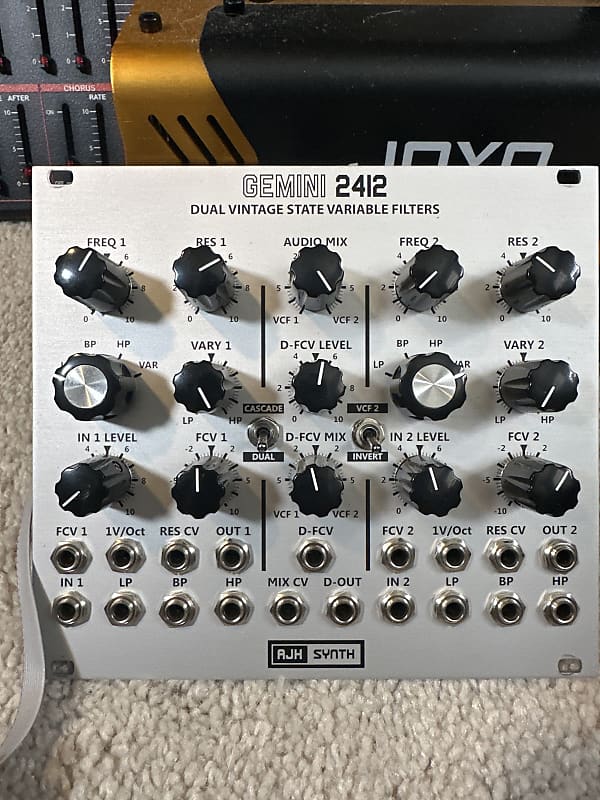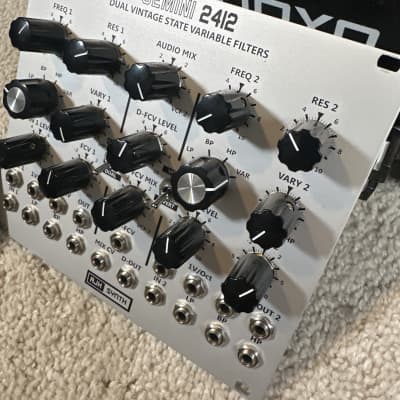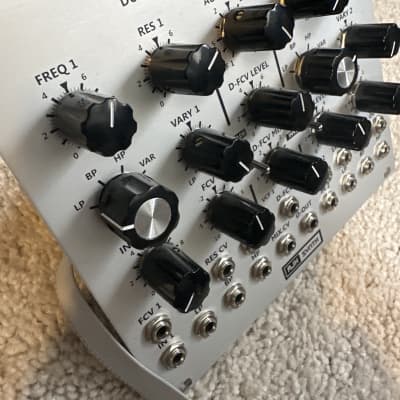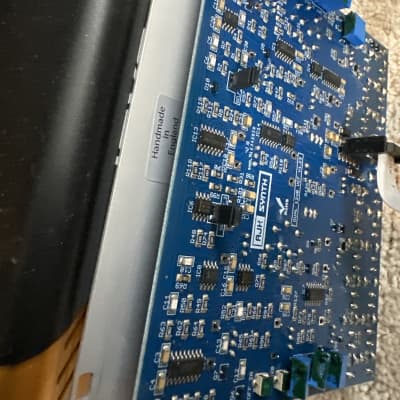For your consideration a mint condition wonderful sounding SEM style variable two fully independent filter module. I've ran it through many oscillators, drums, and anything you can think of. I think it's versatile. Please see below for full description. Get it for lower price than others.
—-
The AJH Synth Gemini 2412 is a 28hp wide Eurorack module, featuring two Vintage SEM style, state variable voltage controlled filters, along with a versatile central mixing bus allows which them to be combined in series, parallel or parallel inverted modes. A dual, variable frequency control system allows single control of cutoff frequency of both filters, and the actual CV amount sent to each filter can be set using the D-FCV MIX control.
Two fully Independant 12dB Multimode VCF's
The left and right sides of the module are taken up with VCF 1 and VCF2, which are completely independant from each other. Each has its own Input (IN 1 and IN 2) and Low Pass, Band Pass and Hign pass outputs. Out 1 is selectable with the four way rotary switch (LP, BP, HP or VARY), additionally the mode of VARY can be swept from LP (Vary control at LP) to Notch (Vary control centred) to HP (Vary knob at HP). As well as being routed to the OUT 1 or (OUT 2) jacks, this output is also sent to the central mixer bus for combining VCF 1 and VCF 2.
Manual Control of Frequency is with Freq 1 (or Freq 2) controls, and there is also a Frequency CV input (FCV 1 and FCV2) allowing the level of Frequency modulation to be voltage controlled. The FCV1 and FCV2 level controls are attenuverters rather than regular level controls, this means that in the centre (approx 12 o'clock) position, none of the modulation voltage patched to the FCV1 (or FCV2) input will affect the cut off frequency of the filter, however as the FCV 1 (or FCV2) control is turned clockwise from centre then the voltage or waveform applied to the FCV input will increasingly affect filter frequency. If the control is turned anti-clockwise from centre then an INVERTED voltage or waveform is applied to the filter cut off frequency, as an example, if we applied a +5V DC voltage to the FCV input, if the FCV control is rotated ant-clockwise than this would apply an increasing negative voltage to the filter cutoff, rather than a positive voltage if FCV control is rotated clockwise of centre. This is much more useful tha a regular level control, as it combines both level control and inverter in one convenient control.
There is also a 1V/Octave frequency control input too, this allows the filter to open at 1V/Octave for keyboard tracking, or correctly pitched sounds if the filter is in self resonating mode. It can also be used as a second frequency CV contol, and this can be very useful when combined with an CV external mixer, such as the AJHSynth CV MIX, Offset / VCA module - which would allow multiple modulation sources to be mixed. And of course the 1V / Oct control works at the same time as the FCV input too, so for example the output of an envelope generator could be patched to the FCV input and the output of a Midi/CV converter or sequencer to 1V/Octave input so that both envelope and pitch tracking are possible simultaniously.
Three different Dual Modes
The two independant filters can be combined in three different ways:
Serial (Cascade) Mode
The mode toggle switch should be set to CASCADE position to select this mode.This connects the OUT 1 output from filter one to the IN 2 input of filter 2, and both filter one and two outputs are routed to the inbuilt cross-fader, the output of which is routed to the D-OUT output.So the signal is first treated by filter one, then this filtered signal is fed for further filtering by filter two.The four way rotary switches select the filter type for each filter signal sent to the Cross Fader, and the AUDIO MIX contol allows crossfading between the filter one and filter two outputs, so in this case we are cross-fading between one and two filters. So if, for example, both filter one and filter two are set to Low Pass (LP) mode, then the AUDI MIX contol will fade between 12dB and 24dB Low Pass filter slopes.
As another example, selecting LP filter for filter one and HP filtering for filter two will combine to give a Band Pass responce, but the frequency and resonance for each component can be individually controlled. This is quite different from using the BP setting on one of the individual filters, as it doubles the BP filter slope from 6dB to 12dB, but allows much more control over the BP characteristics too, andin this case the AUDIO MIX control would fade between LP (filter one) and BP (filter one and two in series). And of course any filter type from filter one and filter two can be combined.
Parallel (Dual) Mode
The mode toggle switch should be set to CASCADE position, and the INVERT switch set to VCF2 position to select this mode.This internally connects the output of filter one to the VCF 1 crossfader input, and the output of filter two to the VCF 2 crossfader input, so the crossfader output D-OUT is a mix of filter one and two. With the AUDIO MIX contol at the 12 'oclock position a 50/50 mix of filter one and filter two will be heard, but if the AuDIO Mix is turned to zero (VCF 1) position then only the output of filter one will be heard, and if turned to the VCF2 position then only VCF2 will be heard, and as the AUDIO MIX control can be voltage controlled we can automate cross-fading between the two filters. As an example, using the four way rotary switchs we could set VCF1 to LP mode and VCF2 to HP mode, then manually (with the AUDI MIX control) cross fade from a LP to HP filter type, or we could use a 0 to +5V or higher contol voltage to do this automatically under voltage control. We could even use the vary outputs for both VCF1 and VCF2 to feed the crossfader, so it is possible to continually vary the invididual filter type at the same time as cross fading between filters one and two!
INVERTED Parallel (Dual) Mode
The mode toggle switch should be set to CASCADE position, and the INVERT switch set to INVERT position to select this mode.This is the same as Parallel mode (above) however the output of VCF2 is inverted before being sent to the crossfader VCF2 input, so VCF 2 is inverted against VCF1, which causes phase cancellations between the two filters when they are mixed together..
Versatile Central Mixing Bus
The central mixing bus comprises control knobs for Audio MIX, Dual frequency control level (D-FCV) and Dual FCV mixing (D-FCV Mix), and it includes two CV Inputs, MIX CV input which allows voltage control of audio crossfading of the outputs of VCF1 and VCF2. There is also the D-FCV Input, which allows a dual frequency control voltage to be sent to both VCF1 and VCF2 simultaniously (or if no external CV is patched in it includes a, the amount being controlled by the D-FCV level control, and the amount sent to VCF1 and VCF2 can be controlled by the D-FCV Mix control. With D-FCV MIX in the centre position, an equal amount of frequency control voltage from the D-FCV input is routed to both VCF1 and VCF2, however if the D-FCV MIX is turned fully anti-clockwise then the incoming D-FCV voltage will be routed to VCF1 frequency only, likewise with the D-FCV MIX control fully clockwise all of the D-FCV contol voltage is routed to VCF2.
If no patch cable id plugged into the D-FCV Input socket then an internal voltage source is applied to the D-FCV Level control, so that Manual adjustment of the D-FCV Level control will change the frequency of one or both filters, again depending upon the setting of the D-FCV MIX control. This is very useful as it allows the cut-off frequency of both filters to be adjusted in varying mix amounts from a single control knob.
Self Oscillation
The vintage SEM filter is a beautiful sounding and very versatile filter with an unmistakeable sound, however it was not capable of self oscillation at high Resonance settings, so could not be used as a sine wave oscillator, nor could self oscillation be added to an input signal. As this is a useful addition we have added two jumpers to the rear panel, and it can be independantly selected for each filter, so for example VCF1 could be configured as a vintage style SEM, whilst VCF2 could have self oscillation ability added, or both VCF's could have it added as desired.
In self oscillation mode the filter will track 1V/Octave reasonably well over a four octave range, but because the tracking is not temperature compensated it may be necessary to use a module such as our V-Scale buffer to allow the 1V/Octave tracking slope to be slightly changed to get it to track perfect octaves. The sine wave produced is not perfect, it has a very slight asymetrical shape which can add very low levels of harmonics, however t still sounds pretty similar to a perfect sine wave.
It should be noted that when self resonant mode is selected the output signal becomes considerably higher (hotter) than the usual 10V p/p Eurorack level, so if the filter output is being fed into modules downstream (such as a VCA, Ring Modulator etc) then the input level control on this downstream module should be attenuated to prevent it from being overloaded and creating clipping distortion.
Overdrive Mode
Sometimes it can be nice to overdrive a filter to get a fatter, more distorted sound - so we have built this facility in too and it is part of the Input level control function. To keep the sound fairly clean then make sure that the IN 1 (or IN 2 level) controls are kept to position 8 or lower, turning the control knob higher than 8 increases the level further and overdrives the filter core.
The SEM filter is only 12dB, I wish it had a 24dB per octave cutoff slope
Yes, that is true if you only use one of the filters on the Gemini, however, by combining both filters in CASCADE Mode (and using the same front panel filter mode, frequency and resonance settings) it then becomes a 24dB/Oct SEM filter! Hence the Gemini 2412 name...
Just use a couple of split patch cables or multiples to give equal voltage control of Frequency and Resonance, or use the D-FCV central bus feature for symetrical or asymetric control of cutoff frquency. So it's a 24dB SEM filter with a few more tricks up its sleeve too!







